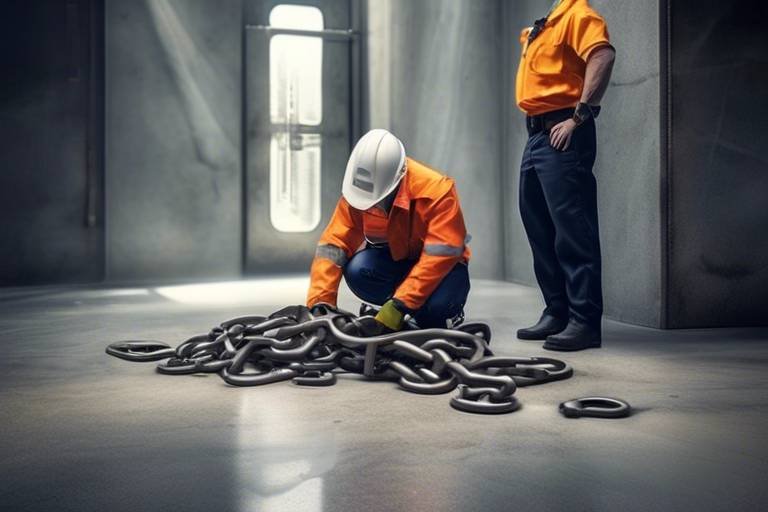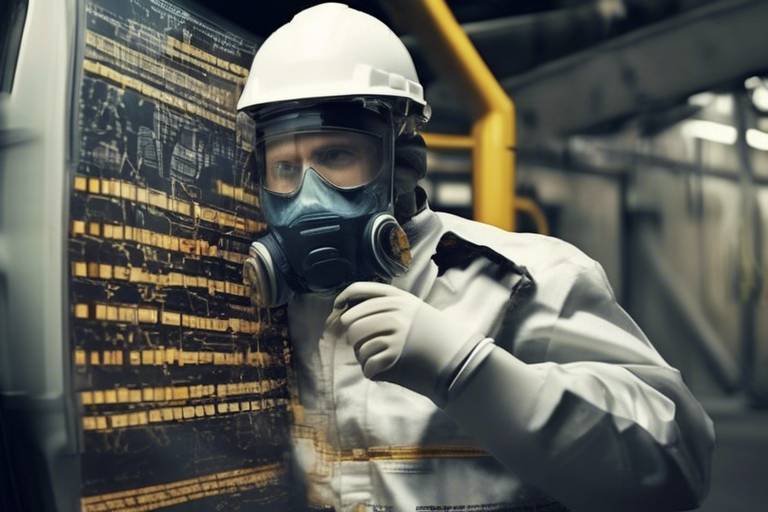The Nexus between Safety Procedures and Human Behavior
In today's fast-paced world, the intersection of safety procedures and human behavior is more crucial than ever. Imagine a bustling construction site or a busy hospital; the established safety protocols are like the backbone of these environments, designed to protect lives and ensure smooth operations. However, what happens when the very people meant to follow these procedures don't? This article dives deep into the intricate relationship between safety protocols and the human element, shedding light on how understanding this connection can lead to improved safety outcomes.
Safety procedures are not just a set of rules; they are essential frameworks that help minimize risks and create a safer workplace. Think of them as the traffic lights of a busy intersection; they guide behavior and prevent chaos. When adhered to, these protocols can significantly reduce the likelihood of accidents and injuries. For instance, in a manufacturing plant, safety procedures dictate everything from proper equipment usage to emergency evacuation protocols. Without these guidelines, the risk of accidents skyrockets, endangering not only individual employees but also the entire organization.
However, the effectiveness of these safety procedures hinges on one critical factor: human behavior. Understanding why people comply—or fail to comply—with safety protocols is essential for organizations aiming to cultivate a culture of safety. Various factors influence adherence to safety measures, including personal beliefs, past experiences, and even workplace dynamics. It’s like trying to solve a puzzle; every piece matters, and the picture is incomplete without a thorough understanding of each component.
Motivation plays a pivotal role in determining whether individuals will follow safety procedures. Think about it: if someone believes that following a safety protocol is beneficial, they're more likely to comply. This motivation can be categorized into two types: intrinsic and extrinsic. Intrinsic motivation stems from personal satisfaction or a sense of duty, while extrinsic motivation comes from external rewards or recognition. Organizations can enhance these motivational factors by creating incentive programs that reward safe behavior or by fostering an environment where employees feel valued and empowered to speak up about safety concerns.
The culture within an organization also significantly affects employees' attitudes toward safety. A positive safety culture can lead to better adherence to safety protocols, while a negative culture can breed complacency and negligence. When employees feel that safety is prioritized and valued, they are more likely to engage in safe practices. This cultural shift can be achieved through leadership commitment, open communication, and regular feedback on safety performance. It’s akin to nurturing a garden; with the right care and attention, a thriving culture of safety can blossom.
Moreover, effective training and education are vital components in promoting safety compliance. Ongoing training programs equip employees with the knowledge and skills necessary to adhere to safety protocols. These programs should not be one-off events but rather continuous learning opportunities that evolve with changing workplace dynamics. For example, regular drills and refresher courses can help keep safety top of mind and reinforce the importance of compliance. Just like a sports team practices regularly to enhance performance, organizations must invest in training to cultivate a safety-oriented workforce.
Behavioral interventions also play a crucial role in enhancing safety compliance. By implementing targeted strategies, organizations can modify behaviors and encourage adherence to safety protocols. This could involve using reminders, conducting safety audits, or even employing behavioral nudges that subtly guide individuals toward safer choices. It’s all about creating an environment where safety becomes second nature, much like buckling your seatbelt before driving; it’s a habit that protects you without needing to think twice.
In conclusion, the nexus between safety procedures and human behavior is a dynamic relationship that requires attention and understanding. By recognizing the importance of safety procedures, the impact of human behavior, and the roles of motivation, culture, and training, organizations can create safer environments that protect employees and enhance overall productivity.
- Why are safety procedures important? Safety procedures help minimize risks and prevent accidents in the workplace.
- How does human behavior affect safety compliance? Human behavior influences whether individuals adhere to safety protocols, which can be affected by motivation, culture, and training.
- What role does motivation play in safety adherence? Motivation can be intrinsic or extrinsic, and it significantly impacts an individual's willingness to follow safety procedures.
- How can organizations foster a positive safety culture? By prioritizing safety, encouraging open communication, and providing regular training, organizations can cultivate a culture that values safety.
- What are behavioral interventions in safety compliance? Behavioral interventions are strategies implemented to modify behaviors and encourage adherence to safety protocols.

The Importance of Safety Procedures
This article explores the intricate relationship between established safety protocols and the influence of human behavior on their effectiveness, highlighting the importance of understanding this connection for improved safety outcomes.
Safety procedures are the backbone of any organization aiming to minimize risks and protect its workforce. Imagine walking into a construction site without any safety measures in place; it would be like driving a car without brakes! These procedures are meticulously designed to create a safer workplace, ensuring that employees are aware of potential hazards and know how to avoid them.
One of the primary roles of safety procedures is to prevent accidents and injuries. They act as a roadmap, guiding employees through the often treacherous landscape of workplace risks. For instance, in environments where heavy machinery is in use, safety protocols dictate the proper use of equipment, personal protective gear, and emergency procedures. Without these guidelines, the likelihood of accidents skyrockets, leading not just to injuries but also to significant financial losses for the organization.
Moreover, effective safety procedures foster a culture of accountability. When everyone in the organization understands and adheres to these protocols, it creates an environment where safety is prioritized. Employees feel more secure, knowing that their well-being is valued, which can significantly enhance overall productivity. In fact, a study by the National Safety Council found that organizations with robust safety programs experience up to a 40% reduction in workplace injuries.
To illustrate the importance of safety procedures, consider the following table that highlights key benefits:
| Benefit | Description |
|---|---|
| Accident Prevention | Reduces the likelihood of workplace injuries and accidents. |
| Employee Well-being | Enhances the overall safety and health of employees. |
| Legal Compliance | Ensures adherence to local and federal safety regulations. |
| Improved Morale | Promotes a positive workplace atmosphere, leading to higher employee satisfaction. |
In conclusion, safety procedures are not just bureaucratic red tape; they are essential frameworks that safeguard employees and enhance organizational efficiency. As we delve deeper into the relationship between human behavior and safety compliance, it becomes clear that understanding this connection is vital for creating a culture where safety is ingrained in every action.
Understanding human behavior is crucial for ensuring compliance with safety procedures. This section examines factors that influence adherence to safety protocols and the psychological aspects at play.
Motivation significantly impacts individuals' willingness to follow safety procedures. This subsection delves into intrinsic and extrinsic motivators that drive compliance and how organizations can enhance these factors.
An organization's culture shapes employees' attitudes towards safety. This segment explores how fostering a positive safety culture can lead to better adherence to safety protocols and overall improved outcomes.
Effective training and education are vital for promoting safety compliance. This part discusses the importance of ongoing training programs and their influence on employee behavior regarding safety procedures.
Implementing behavioral interventions can enhance safety compliance. This section outlines various strategies that organizations can adopt to modify behaviors and encourage adherence to safety protocols.
Non-compliance with safety procedures can have severe consequences. This section highlights the potential risks and repercussions of failing to follow established safety protocols in different environments.
Organizations face legal and financial repercussions due to safety non-compliance. This subsection examines the potential liabilities and costs associated with accidents resulting from inadequate adherence to safety procedures.
Non-compliance can negatively affect employee morale. This part discusses how safety incidents impact team dynamics and overall workplace atmosphere, emphasizing the need for compliance to maintain a positive environment.
- What are safety procedures? Safety procedures are guidelines designed to ensure a safe working environment, detailing how to handle specific situations and risks.
- Why are safety procedures important? They minimize risks, prevent accidents, and create a culture of safety within the workplace.
- How can organizations improve safety compliance? By fostering a positive safety culture, providing effective training, and implementing behavioral interventions.
- What are the consequences of not following safety procedures? Non-compliance can lead to accidents, legal repercussions, and a decline in employee morale.

When it comes to safety compliance, understanding human behavior is absolutely crucial. Why? Because safety procedures, no matter how well-crafted, are only as effective as the people who implement them. Imagine a beautifully designed safety manual sitting on a shelf, gathering dust. It’s a bit like having a fire extinguisher that no one knows how to use. The key lies in recognizing that human behavior plays a pivotal role in whether safety protocols are followed or ignored.
Several factors influence adherence to safety protocols, and these can be broadly categorized into psychological, social, and environmental factors. For instance, psychological factors include an individual's perception of risk. If workers underestimate the dangers associated with their tasks, they are less likely to follow safety guidelines. This phenomenon is often referred to as the illusion of invulnerability, where individuals feel that accidents happen to others, not to them. It’s like driving a car and thinking, “I’m a great driver; I’ll never get into an accident.”
Social factors also play a significant role in safety compliance. Peer pressure can either encourage adherence to safety rules or lead to a culture of non-compliance. If employees see their colleagues ignoring safety procedures without consequences, they might feel compelled to do the same. This is where the organizational culture becomes essential. A culture that prioritizes safety can foster an environment where employees feel empowered to speak up about unsafe practices and hold each other accountable.
Moreover, environmental factors, such as the availability of safety equipment and the physical workspace, can significantly impact compliance. For instance, if safety gear is hard to access or uncomfortable to wear, workers might skip it altogether, putting themselves at risk. The design of the workplace itself can either facilitate or hinder safe practices. Think about it: a cluttered workspace can lead to accidents, just like a poorly designed assembly line can create hazards. Thus, organizations must create environments that support safe behaviors.
To further illustrate the complex relationship between human behavior and safety compliance, consider the following table that summarizes key factors influencing adherence:
| Factor | Description |
|---|---|
| Psychological Factors | Individual perceptions of risk and personal beliefs about safety. |
| Social Factors | Peer influence and organizational culture affecting compliance. |
| Environmental Factors | Accessibility of safety equipment and the physical workspace design. |
In conclusion, understanding human behavior is not just an academic exercise; it’s a practical necessity for improving safety compliance. By addressing the psychological, social, and environmental factors that influence behavior, organizations can create a more robust safety culture that encourages adherence to protocols. After all, a safety procedure is only as good as the people who follow it. So, how can organizations ensure that their safety procedures are not just written words but are actively practiced? The answer lies in fostering an environment where safety is a shared value, not just a rule.
- What are the main factors influencing safety compliance?
The main factors include psychological perceptions, social influences, and environmental conditions.
- How can organizations improve safety adherence?
By creating a positive safety culture, providing accessible training, and ensuring that safety equipment is readily available.
- Why is understanding human behavior important in safety compliance?
Understanding human behavior helps organizations tailor their safety protocols to be more effective and encourages employees to follow them.

When it comes to the world of safety procedures, one of the most compelling factors influencing adherence is motivation. Think of motivation as the fuel that drives the engine of compliance; without it, even the best-laid safety plans can stall. But what exactly fuels this motivation? It can be broadly categorized into two types: intrinsic and extrinsic motivators. Intrinsic motivation comes from within, such as a personal commitment to safety or a sense of responsibility towards colleagues. On the other hand, extrinsic motivation is often driven by external factors, like rewards, recognition, or even fear of repercussions.
Understanding these motivators is crucial for organizations aiming to enhance safety adherence. For instance, when employees feel a personal connection to safety, they are more likely to follow protocols diligently. This is where the role of leadership and management becomes vital. Leaders who actively promote safety as a core value can inspire their teams to take ownership of their safety practices. They can do this by:
- Communicating the importance of safety regularly.
- Recognizing and rewarding safe behaviors.
- Providing opportunities for employees to voice their safety concerns.
But let's not kid ourselves; motivation is not a one-size-fits-all solution. Different individuals may respond to different motivators. For example, while one employee may thrive on praise and recognition, another may be more motivated by the fear of accidents or injuries. Therefore, organizations must adopt a tailored approach to motivation, understanding that a mix of both intrinsic and extrinsic factors can lead to optimal safety adherence.
Moreover, organizations can enhance motivation through structured training programs. These programs should not only focus on the 'how' of safety procedures but also the 'why.' When employees understand the reasoning behind safety protocols, they are more likely to internalize them, leading to better compliance. Think of it this way: if you know why you need to wear a helmet while riding a bike, you’re more likely to put one on, right? It's about creating a culture where safety is seen as a shared responsibility rather than just a checklist to tick off.
In conclusion, motivation plays a pivotal role in ensuring adherence to safety procedures. By recognizing the different types of motivators and fostering an environment that encourages personal investment in safety, organizations can significantly improve compliance rates. After all, a motivated workforce is not just safer; it’s also more engaged and productive.
- What are intrinsic and extrinsic motivators?
Intrinsic motivators are internal factors that drive individuals, such as personal satisfaction and responsibility. Extrinsic motivators are external factors, like rewards or recognition. - How can organizations improve safety adherence?
By fostering a positive safety culture, providing effective training, and recognizing safe behaviors, organizations can enhance motivation and compliance. - Why is understanding motivation important for safety?
Understanding motivation helps organizations tailor their safety programs to meet the needs of their employees, leading to better adherence and safer work environments.

When we think about safety in the workplace, it’s easy to get caught up in the technicalities of procedures and protocols. However, the organizational culture plays a pivotal role in shaping how these safety measures are perceived and followed by employees. Imagine a ship navigating through turbulent waters; the captain’s leadership and the crew’s morale can make all the difference in steering it to safety. In the same way, a positive safety culture can guide employees toward better adherence to safety protocols, ultimately preventing accidents and promoting well-being.
A strong safety culture is characterized by open communication, shared values, and a collective commitment to safety. When employees feel that their voices are heard and their concerns are valued, they are more likely to engage with safety practices. This creates an environment where safety is not just a set of rules to follow, but a fundamental aspect of the workplace ethos. Think of it as a community where everyone looks out for one another; this sense of belonging can significantly enhance compliance with safety procedures.
To illustrate the impact of organizational culture on safety adherence, consider the following table that highlights key elements of a positive safety culture and their effects on employee behavior:
| Key Element | Effect on Employee Behavior |
|---|---|
| Open Communication | Encourages reporting of hazards and near-misses without fear of reprisal. |
| Leadership Commitment | Demonstrates that safety is a priority, inspiring employees to take it seriously. |
| Recognition and Rewards | Motivates employees to adhere to safety protocols through positive reinforcement. |
| Continuous Improvement | Fosters a proactive approach to safety, where employees are encouraged to suggest enhancements. |
Moreover, fostering a positive safety culture can also mitigate the effects of human error. Employees are less likely to cut corners or overlook safety measures when they understand that their organization prioritizes safety. They feel empowered to speak up about unsafe practices, leading to a more vigilant workforce. In essence, a robust safety culture acts as a safety net, catching potential issues before they escalate into serious incidents.
Organizations can cultivate this culture through various initiatives, such as regular safety meetings, team-building activities focused on safety, and training sessions that emphasize the importance of safety in daily operations. By embedding safety into the organizational DNA, companies can ensure that it becomes an integral part of the work environment rather than an afterthought. After all, when safety becomes a shared value, everyone wins—employees feel safer, and organizations reap the benefits of reduced incidents and increased productivity.

When it comes to safety compliance, the impact of training and education cannot be overstated. Think of it as the foundation of a sturdy building; without it, everything else is at risk of collapsing. Effective training programs equip employees with the necessary skills and knowledge to navigate their work environments safely. Imagine walking into a construction site where workers aren’t wearing helmets or harnesses. It’s a recipe for disaster, right? This is where comprehensive training comes into play, ensuring that each employee understands the importance of safety protocols and how to implement them in their daily routines.
Moreover, ongoing education is crucial in keeping safety practices fresh in the minds of employees. Just like we need regular check-ups to maintain our health, safety training should also be a recurring event. Organizations that prioritize continuous learning often see a significant reduction in workplace incidents. For instance, a company might implement quarterly safety workshops that not only refresh employees’ knowledge but also introduce new safety technologies and practices. This proactive approach fosters a culture where safety is not just a checkbox but a core value.
In addition, the format of training plays a vital role in its effectiveness. Traditional classroom settings can sometimes feel monotonous, leading to disengagement. Incorporating interactive elements such as hands-on training, simulations, and even online modules can enhance learning outcomes. Employees are more likely to retain information when they are actively involved in the learning process. For example, a simulation of emergency evacuation procedures can be far more impactful than simply reading about it in a manual. The thrill of practice can create lasting impressions.
To illustrate the importance of tailored training programs, consider the following table:
| Training Method | Effectiveness | Employee Engagement |
|---|---|---|
| Classroom Training | Moderate | Low |
| Hands-On Training | High | High |
| Online Modules | Moderate | Moderate |
| Simulation Exercises | Very High | Very High |
As you can see, hands-on training and simulation exercises yield the best results in both effectiveness and employee engagement. This highlights the necessity for organizations to invest in innovative training methods that resonate with their workforce. When employees feel engaged, they are more likely to absorb the material, leading to better compliance with safety procedures.
Ultimately, the impact of training and education on safety compliance is profound. By fostering an environment where learning is valued and safety is prioritized, organizations can significantly reduce risks and enhance overall workplace morale. Remember, safety is a shared responsibility, and when employees are well-equipped with knowledge and skills, everyone wins. So, how does your organization approach safety training? Are you investing in your most valuable asset—your people?

When it comes to enhancing safety compliance in the workplace, behavioral interventions can be a game changer. These interventions focus on modifying employee behavior to align with established safety protocols. Think of it as planting seeds that grow into a culture of safety; it requires nurturing, attention, and the right environment to flourish. By understanding how people behave and what drives their actions, organizations can implement effective strategies that not only encourage adherence to safety standards but also foster a proactive safety mindset among employees.
One of the most effective behavioral interventions is the use of positive reinforcement. When employees follow safety procedures correctly, recognizing and rewarding their efforts can motivate them to continue doing so. This could be as simple as verbal praise, safety awards, or even small incentives. For instance, consider a monthly recognition program where employees who consistently adhere to safety protocols are celebrated. This not only boosts morale but also reinforces the importance of safety compliance.
Another strategy involves peer influence. Encouraging employees to hold each other accountable can create a sense of community and shared responsibility. When team members support one another in following safety procedures, it cultivates an environment where safety is prioritized. Think of it like a buddy system; when you know someone is watching your back, you're more likely to stay on track. This can be further enhanced by creating safety champions or ambassadors within teams who lead by example and inspire others to comply with safety protocols.
Additionally, organizations can implement behavioral observation programs. These programs involve trained personnel observing employees in their work environment to identify unsafe behaviors and provide immediate feedback. It’s not about policing; rather, it’s about coaching. When employees receive constructive feedback in real-time, they can adjust their behaviors on the spot, leading to immediate improvements in safety practices. This creates a loop of continuous improvement where everyone is on the lookout for ways to enhance safety.
Moreover, effective communication plays a crucial role in behavioral interventions. Regularly sharing safety updates, reminders, and success stories can keep safety at the forefront of employees' minds. Consider implementing safety briefings or toolbox talks that allow employees to discuss safety concerns openly. This not only empowers employees but also fosters a culture where safety is seen as a shared value rather than just a set of rules.
In conclusion, the success of behavioral interventions for safety lies in their ability to engage employees actively. By utilizing strategies such as positive reinforcement, peer accountability, behavioral observations, and effective communication, organizations can create a robust safety culture. Ultimately, when employees feel supported and valued in their efforts to adhere to safety protocols, compliance becomes a natural part of their daily routine.
- What are behavioral interventions? Behavioral interventions are strategies designed to change or modify behaviors to improve safety compliance and overall workplace safety.
- How can positive reinforcement help in safety compliance? Positive reinforcement encourages employees to follow safety protocols by rewarding them for their adherence, thus promoting a culture of safety.
- Why is peer influence important in safety compliance? Peer influence creates a sense of accountability among employees, making them more likely to adhere to safety procedures when they know their colleagues are supportive.
- What role does communication play in safety interventions? Effective communication keeps safety at the forefront of employees' minds, allowing for open discussions about safety concerns and successes.

When it comes to safety procedures, ignoring the rules can lead to a cascade of negative outcomes. Non-compliance isn't just a minor oversight; it can trigger serious repercussions that impact not only the individual but also the entire organization. Imagine a workplace where safety protocols are treated as optional—it's like driving a car without a seatbelt; the risks are significantly heightened. The consequences of non-compliance can manifest in various forms, including physical harm, legal issues, and financial burdens.
One of the most immediate consequences of failing to adhere to safety protocols is the risk of accidents and injuries. These incidents can range from minor injuries to catastrophic events that can endanger lives. For instance, in an industrial setting, neglecting to wear proper protective gear can lead to severe injuries, resulting in lost workdays and increased medical costs. According to statistics, workplaces that prioritize safety procedures see a significant reduction in accident rates, proving that compliance is not just a recommendation but a necessity.
Moreover, the legal implications of non-compliance can be staggering. Organizations may face lawsuits, fines, and penalties if they are found liable for accidents resulting from inadequate safety measures. The legal landscape surrounding workplace safety is stringent, and companies are expected to uphold a duty of care towards their employees. Failing to comply with safety regulations can lead to investigations by regulatory bodies, which can tarnish a company's reputation and lead to costly legal battles.
Financially, the costs associated with non-compliance can spiral out of control. Beyond immediate medical expenses and legal fees, organizations may also face increased insurance premiums and potential loss of business due to damaged reputation. To illustrate, consider the following table that outlines potential costs associated with non-compliance:
| Type of Cost | Description | Estimated Amount |
|---|---|---|
| Medical Expenses | Costs incurred for treating injured employees | $50,000+ |
| Legal Fees | Expenses related to lawsuits and legal defenses | $100,000+ |
| Fines | Penalties from regulatory bodies for non-compliance | $25,000+ |
| Increased Insurance Premiums | Higher costs due to claims and incidents | $10,000+/year |
Additionally, the effects of non-compliance extend to employee morale. When safety incidents occur, they can create an atmosphere of fear and anxiety among staff. Employees may feel that their well-being is not valued, leading to increased turnover rates and decreased productivity. A workplace that emphasizes safety fosters trust and confidence, while a culture of non-compliance breeds resentment and disengagement. It's crucial for organizations to recognize that safety is not just about following rules; it's about cultivating a supportive environment where employees feel secure and valued.
- What are the most common consequences of non-compliance with safety procedures?
Common consequences include workplace injuries, legal repercussions, financial losses, and negative impacts on employee morale. - How can organizations improve compliance with safety protocols?
Organizations can enhance compliance by fostering a strong safety culture, providing regular training, and implementing behavioral interventions. - What role does employee training play in ensuring safety compliance?
Effective training educates employees on safety procedures and reinforces the importance of compliance, leading to a safer workplace. - Can non-compliance affect a company's reputation?
Yes, incidents resulting from non-compliance can damage a company's reputation, leading to loss of business and trust among clients and employees.

When it comes to workplace safety, the stakes are incredibly high. Non-compliance with safety procedures can lead to a myriad of legal and financial repercussions that can cripple an organization. Imagine a scenario where an employee suffers an injury due to a lack of adherence to safety protocols; not only does this impact the individual, but it also opens the floodgates for legal action against the company. The ramifications can be severe, ranging from hefty fines to lawsuits that could drain financial resources.
Organizations must understand that the costs associated with non-compliance are not just limited to immediate financial losses. They can extend into long-term liabilities, including:
- Legal Fees: Defending against lawsuits can be expensive, with legal fees skyrocketing depending on the case's complexity.
- Compensation Payments: Companies may be required to pay compensation to injured employees, which can amount to significant sums.
- Insurance Premium Increases: A history of safety violations can lead to increased insurance premiums, further straining financial resources.
Moreover, the legal landscape surrounding workplace safety is constantly evolving. Regulatory bodies such as OSHA (Occupational Safety and Health Administration) enforce strict compliance standards, and failure to meet these can result in fines that can reach thousands of dollars per violation. For instance, a single citation for a serious violation can cost an organization upwards of $13,653, while willful violations can lead to penalties exceeding $136,532. These figures illustrate just how crucial it is for organizations to prioritize safety compliance.
Additionally, the fallout from non-compliance can have a ripple effect, damaging an organization's reputation. When safety incidents make headlines, it can lead to a loss of trust among clients and customers. Companies may find it challenging to secure contracts or partnerships, as potential collaborators often conduct thorough due diligence regarding safety records. This loss of business can have devastating financial consequences, further emphasizing the need for robust safety procedures.
In summary, the legal and financial ramifications of non-compliance with safety procedures are profound. Organizations must not only adhere to safety regulations but also cultivate a culture of safety that prioritizes employee well-being. By investing in safety compliance, companies can protect themselves from legal troubles and financial losses while fostering a safer, more productive workplace.
- What are the most common legal consequences of safety non-compliance?
Common legal consequences include fines, lawsuits, and increased insurance premiums. - How can organizations mitigate financial risks associated with safety non-compliance?
Organizations can mitigate risks by implementing comprehensive safety training programs and regularly reviewing safety protocols. - What role does employee training play in preventing legal issues?
Effective employee training ensures that all staff members are aware of safety procedures, significantly reducing the likelihood of accidents and subsequent legal actions.

Non-compliance with safety procedures can have a profound impact on employee morale, creating a ripple effect that extends throughout the entire organization. When safety protocols are ignored or inadequately enforced, it sends a message to employees that their well-being is not a priority. This perception can lead to a range of negative emotions, including frustration, anxiety, and distrust towards management. Employees may feel that their safety is being compromised, which can diminish their overall job satisfaction and engagement.
Moreover, when safety incidents occur due to non-compliance, the aftermath can be devastating not just for the individuals directly involved, but also for their colleagues. Witnessing a colleague suffer from a preventable accident can create a work environment steeped in fear and uncertainty. Employees may start to question their own safety, leading to increased stress levels and decreased productivity. This situation can escalate into a toxic work culture where employees are constantly on edge, fearing that they could be next.
Interestingly, the effects on morale are not just limited to those who are directly involved in safety incidents. The entire team can feel the repercussions. For example:
- Team Dynamics: Non-compliance can disrupt the harmony within teams. Employees may become hesitant to collaborate, fearing that their peers are not following safety protocols, which can lead to isolation and decreased teamwork.
- Trust Issues: When safety measures are disregarded, trust between employees and management can erode. Employees may feel that management is not transparent about safety risks or is indifferent to their welfare.
- Increased Turnover: A culture that lacks a commitment to safety can result in higher turnover rates. Employees are likely to seek employment elsewhere if they feel unsafe or undervalued.
In summary, the consequences of non-compliance with safety procedures extend far beyond immediate physical risks. The psychological impact on employee morale can lead to a disengaged workforce, increased turnover, and a toxic work environment. Organizations must recognize the importance of fostering a culture of safety, where adherence to protocols is not just a requirement but a shared value. By prioritizing safety, companies can significantly enhance employee morale, leading to a more productive and harmonious workplace.
- What are the signs of low employee morale due to safety issues?
Signs can include increased absenteeism, lack of enthusiasm, decreased productivity, and open complaints about safety practices. - How can organizations improve employee morale related to safety?
Organizations can improve morale by actively engaging employees in safety discussions, providing regular training, and ensuring that all safety protocols are followed consistently. - What role does communication play in maintaining safety compliance?
Effective communication is crucial as it ensures that all employees are aware of safety procedures and feel empowered to voice concerns or suggestions.
Frequently Asked Questions
- What are safety procedures and why are they important?
Safety procedures are systematic methods designed to minimize risks and protect individuals in various environments. They are crucial because they help prevent accidents and injuries, ensuring a safer workplace and promoting overall well-being. Think of them as the rules of the road that keep everyone on track and out of harm's way.
- How does human behavior affect safety compliance?
Human behavior plays a significant role in how well safety procedures are followed. Factors such as individual attitudes, motivation, and organizational culture can greatly influence compliance. If people don't see the value or necessity of these procedures, they may ignore them, leading to potential risks and accidents.
- What motivates individuals to adhere to safety protocols?
Motivation can be both intrinsic and extrinsic. Intrinsic motivators include personal values and the desire to stay safe, while extrinsic motivators might involve rewards or recognition from the organization. By understanding what drives their employees, organizations can implement strategies that enhance these motivators, leading to better safety adherence.
- How does organizational culture influence safety compliance?
An organization's culture is like the air we breathe; it shapes attitudes and behaviors. A positive safety culture encourages employees to prioritize safety, fostering an environment where everyone feels responsible for following procedures. When employees believe that safety is valued by their organization, they are more likely to comply with established protocols.
- Why is training and education essential for safety compliance?
Ongoing training and education are vital for reinforcing safety procedures and ensuring that employees are aware of the latest protocols. Regular training helps keep safety top of mind and equips individuals with the knowledge and skills they need to act safely in their roles. It's like a refresher course that keeps everyone sharp and ready to tackle potential hazards.
- What are some behavioral interventions that can enhance safety compliance?
Behavioral interventions can include strategies like positive reinforcement, safety incentives, and regular feedback. These methods aim to modify behavior by encouraging safe practices and discouraging unsafe ones. By creating a supportive environment that recognizes compliance, organizations can significantly improve adherence to safety protocols.
- What are the consequences of non-compliance with safety procedures?
Non-compliance can lead to serious consequences, including accidents, injuries, and even fatalities. Additionally, organizations may face legal and financial ramifications, such as lawsuits or fines. Not to mention, the impact on employee morale can be detrimental, creating a workplace atmosphere filled with fear and uncertainty.
- How can non-compliance affect employee morale?
When safety procedures are ignored, it can lead to a decline in employee morale. Workers may feel unsafe or undervalued, which can damage team dynamics and create a toxic work environment. A culture of safety is essential for maintaining a positive atmosphere where employees feel secure and valued.



















